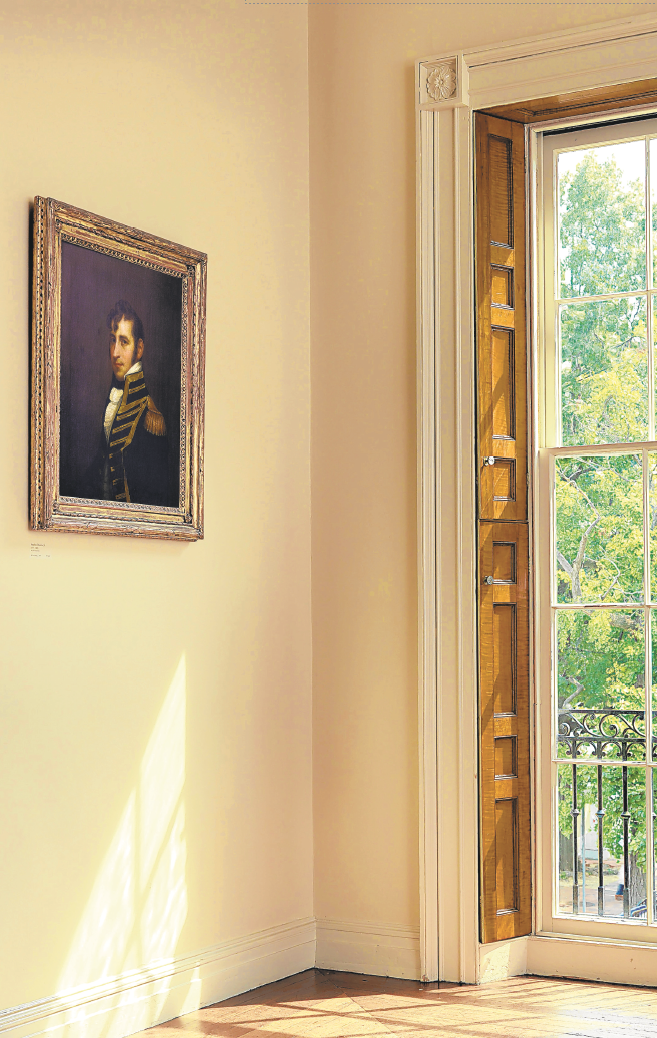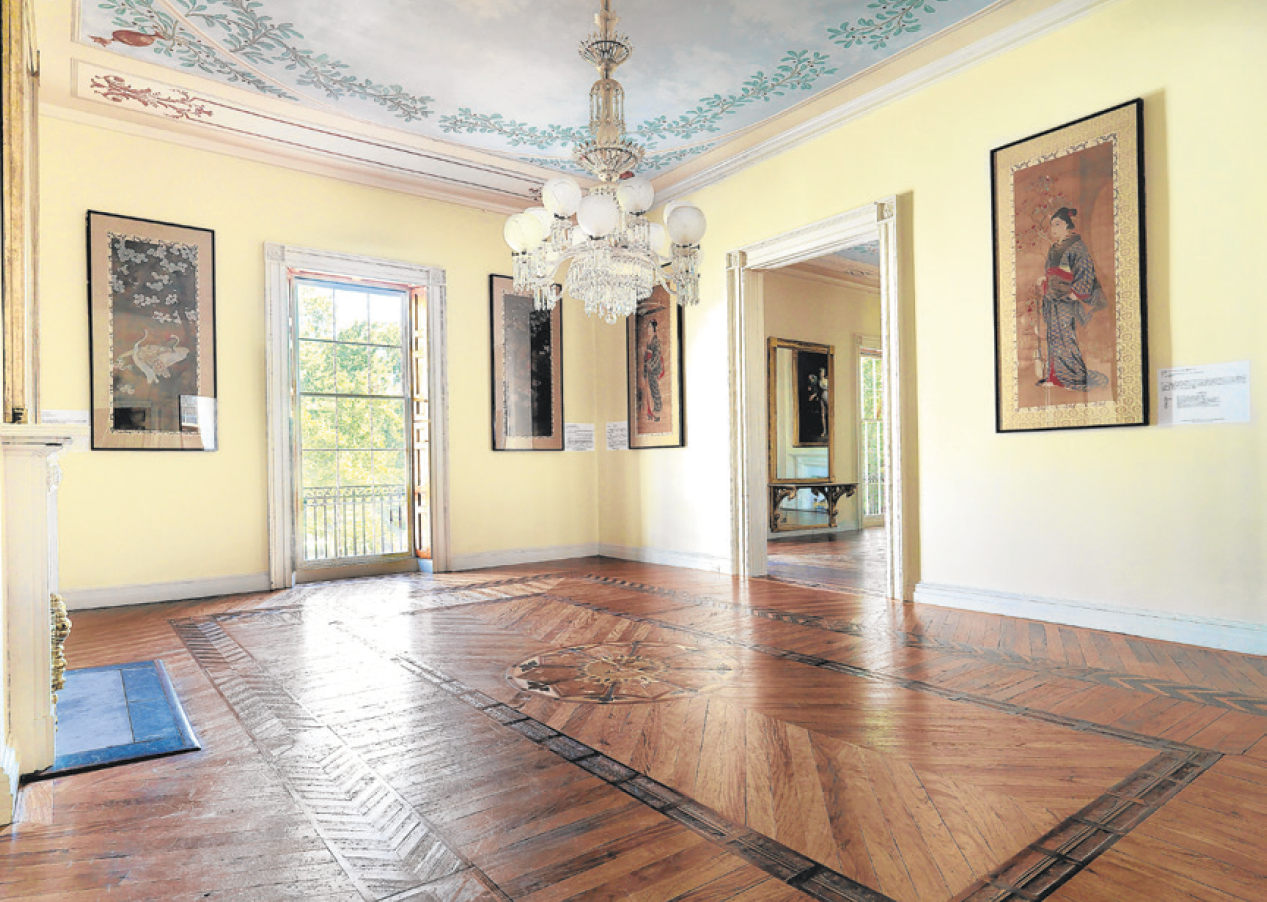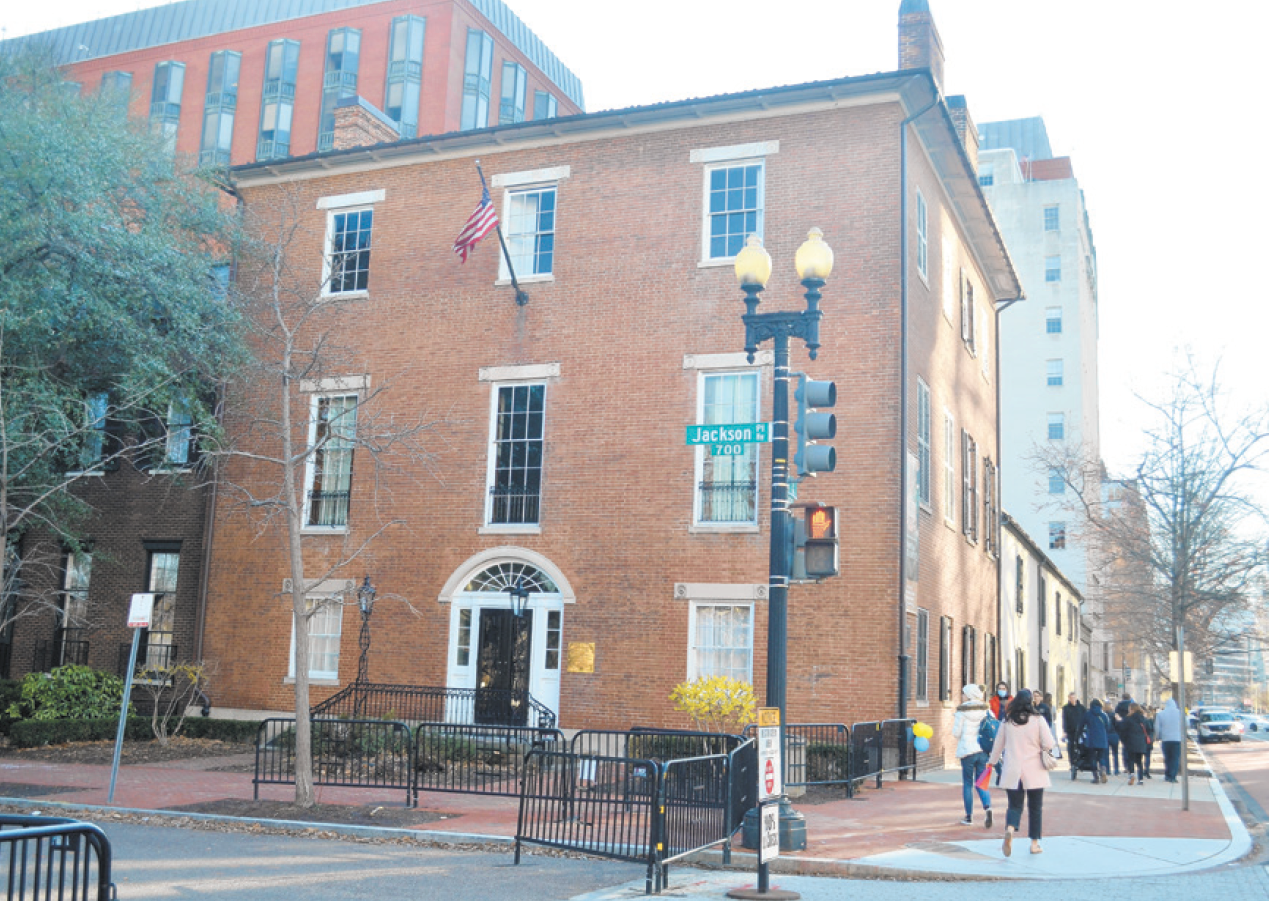The most exclusive rental in US history
A tour of the Decatur House in Washington includes detours through Norfolk, Portsmouth history
By JAMES F. LEE
This photo from the ballroom shows the large windows overlooking Lafayette Square. The portrait of Stephen Decatur is probably by John Vanderlyn, c. 1815. It is a copy of the Decatur portrait by Gilbert Stuart. BRUCE WHITE/WHITE HOUSE HISTORICAL ASSOCIATION
The Virginian-Pilot | Sunday, July 17, 2022
Susan Wheeler Decatur’s husband lay dying in the parlor of their grand house in Washington, D.C., in late March 1820, wounded in a duel with a fellow naval officer. Her husband ordered the door shut, insisting that she not see him suffer in agony. He died at dawn.
Susan was the wife of Commodore Stephen Decatur Jr., a naval hero famous throughout the country for his exploits in the Barbary Wars and the War of 1812, arguably the most popular man in the United States at that time. His funeral was attended by more than 10,000 mourners lining the streets of Washington.
(Decatur was a familiar figure in Norfolk, Susan’s hometown; they married there 14 years before and lived there in the early months of their marriage. The man who shot him, James Barron, was a familiar face too; he was a Hampton native. The Commodore Theatre in Portsmouth is named for him and he’s buried in the courtyard next to it.)
Now, what was Stephen Decatur’s widow to do?
Only 14 months before, she and Stephen had built their elegant home on the corner of Jackson Place Northwest and H Street Northwest, a house made for entertaining, renowned for the galas held in its opulent ballroom. The brick Federal-style, three-story mansion was the first private residence constructed in President’s Park, now Lafayette Square. In time, this would become the city’s most fashionable neighborhood, home
to diplomats, senators, Cabinet secretaries, generals and the capital’s social elite.
My wife, Carol, and I visited Decatur House recently for the weekly tour offered by the White House Historical Association, which manages the property. We were greeted by docent Marga-ret Lineberger. She explained that after Decatur’s death, Susan could not afford to keep up the house, and she decided to rent it out.
Given the house’s location and elegance, she had no trouble finding tenants, including the French and Russian ministers to the United States and three sitting secretaries of state: Henry Clay, Martin Van Buren, and Edward Livingston. Her last tenant was the British minister to the United States.
I couldn’t help thinking that Decatur House became the most exclusive rental in U.S. history.
Susan owned the house until 1836 when it was purchased by John Gadsby, the famous hotelier. It was taken over by the U.S. Army during the Civil War.
Our tour started at the impressive entry, a showcase of neoclassical archways, oval recesses and a curved doorway leading to the main staircase. Be sure to look for the lock in the curved door with an upside-down British coin in it, Decatur’s way of sticking it to the English. To the left is the parlor where he died.
Hampton Roads readers will be interested to know that Decatur was killed with one of the duel-ing pistols borrowed from John Myers of Norfolk, a friend of his adversary, and currently on view at the Moses Myers House on East Freemason Street.
Decatur items in the parlor include a desk from his ship, the USS President, and a ceremonial sword given to him by the Commonwealth of Virginia for his actions in capturing HMS Macedonian during the War of 1812. Other furnishings come from the Beale family, owners of the house from 1871 to 1956, and include twin couches from the 1870s and a pair of candelabra on the mantel.
The family dining room is set with items from the Beale family and period pieces from the collection of the White House Historical Association. Portraits on the wall include Stephen Decatur Jr. and his father, and a fascinating painting depicting the camel brigade commanded by Edward Beale in his survey expeditions of the Southwest.
ern explorer, surveyor, rancher and later a diplomat who made his fortune in California. He and his wife, Mary, purchased the house in 1871 and initiated extensive renovations, restoring it as a center of Washington entertainment. Their son, Truxtun, inherited the house, and upon his death in 1936, it passed to his widow, Marie Oge Beale.
One of the house’s more interesting features is that it was built with the kitchen as a first-floor front room. At the time, a kitchen in the main house was unusual because of heat, odors and fire risk. Later the room served as a billiard room and a study. Today it is used for storage.
We climbed the back stairway used by the family and by servants and enslaved people carrying food, water, laundry and wood to the third-floor bedrooms, which today are closed to the public. On the second floor, we entered the large formal dining room with floor-to-ceiling windows and flowery stencil work on the ceiling. A huge chandelier and an exquisite parquet floor made with 22 varieties of native California wood are additions by the Beales. The Great Seal of California is inlaid in the center of the floor.
The next room, the ballroom, is really the heart of the house. I could easily imagine foreign diplomats and secretaries of state holding balls and receptions here. Tall windows fronting the square let in light that illuminates the grape leaves and urns stenciled on the high ceiling. Today, portraits of Stephen and Susan Decatur flank the entranceway.
Our guide pointed to the wavy patterns in some of the window panes, indicating that these are original to the house. Carol couldn’t help thinking about all those famous people who lived or visited here looking out these same windows at Lafayette Square.
Stephen Decatur died in this first-floor parlor on March 22, 1820, from wounds suffered in a duel. The ceremonial sword on the mantel was presented to him by the commonwealth of Virginia for his capture of HMS Macedonian during the War of 1812. JAMES F. LEE
The formal dining room on the second floor of Decatur House shows the influence of Edward and Mary Beale. BRUCE WHITE/WHITE HOUSE HISTORICAL ASSOCIATION
The Decatur House on the corner of Jackson Place Northwest and H Street Northwest. Stephen and Susan Decatur built this house in 1818-19. JAMES F. LEE
But not all the residents of Decatur House were from the diplomatic and political elite of the time; the house couldn’t operate without domestic servants and enslaved people. While there is no evidence that Stephen Deca-tur owned slaves, it is most likely that enslaved labor went into the construction of the house.
A long, two-story ell fronting H Street was added around 1821 to house a new kitchen, storerooms and servants. Dozens of enslaved people occupied the quarters over the years, especially during the ownership of John Gadsby in the decades before the Civil War.
Today, the second floor has been stripped to its studs and chimneys, revealing four rooms used as slave quarters. Panels on the wall explain the role of slavery in Decatur House and in Washington, D.C.
One resident of these quarters was Charlotte Dupuy, an enslaved servant of Henry Clay. She sued him for her freedom, claiming that her previous owner had promised her emancipation and that Clay must honor that request. Clay was about to return to Kentucky; he’d been secretary of state for President John Quincy Adams, who lost his re-election bid in 1828. A court ruled that Dupuy must be allowed to stay in Washington while the case was adjudicated, so she remained in Decatur House after Clay’s departure, working for Van Buren.
Dupuy lost her case. Clay sent agents to forcibly remove her and imprison her in Alexandria, eventually sending her to his daughter’s plantation in Louisiana. She was granted her freedom 11 years later.
In 1936, Edward Beale died.
His wife, Marie, inherited and restored it to its neoclassical elegance, removing many Victorian elements added in the 1870s by her mother-in-law. She entertained lavishly in the ballroom, hosting the annual New Year’s Day reception for diplomats, one of the most sought-after events on the Washington social calendar. But she knew the house’s days were numbered. For years, she resisted the federal government’s plans to retrofit and even demolish the buildings on the square for government office space.
Decatur House was saved by her insightful gift of the property and its contents (and its incredible history) to the National Trust for Historic Preservation shortly before she died in 1956, ensuring that Decatur House would remain as it is forever.
Reach James F. Lee at jameslee@bucknell.edu
IF YOU GO
Where: 748 Jackson Place NW, Washington, D.C.
Hours: Open Mondays only.
Tours at 10:30 a.m. and 1 p.m. Enter the door on H Street Northwest. Tickets: Free
Details: tinyurl.com/WHHAhouse; 202-218-4300



